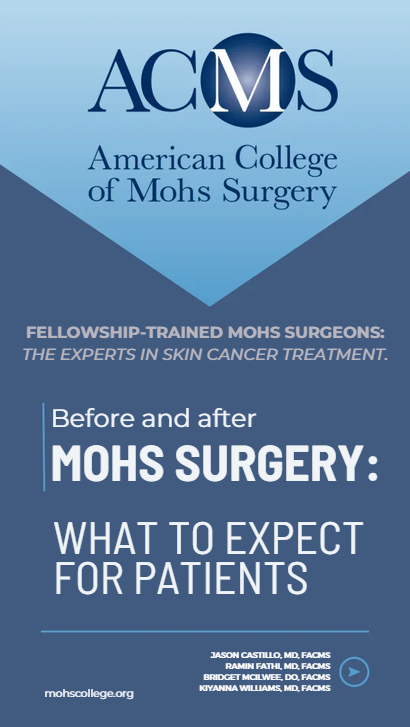Mohs Surgery Post-Operative Care
After a Mohs surgery procedure, most patients find the recovery process simple and easy thanks to the streamlined surgical approach that leaves surrounding tissue unharmed. Nonetheless, it’s common for patients to wonder what they can expect after a Mohs skin cancer surgery. It’s also important to use the post-operative period to plan an ongoing skin cancer detection strategy for the future. This page is intended to help you understand what to expect in the short and long term.
Mohs surgery is the most effective treatment for most types of skin cancer. To learn more about your options, find a fellowship-trained Mohs surgeon in your area.
To help patients understand what to expect following Mohs surgery, the American College of Mohs Surgery published a digital flipbook for patients to learn about common postoperative scenarios. Patients can view the flipbook online here or by clicking the flipbook below.
Immediate Aftercare
After a Mohs surgical procedure, you may or may not undergo a repair process to mend the wound left by the surgery. A number of different reconstruction options exist, and instructions for aftercare are different depending on which approach the surgeon takes.
The surgeon and his or her medical team will provide you with detailed instructions to follow at home, and it’s important you do so in order to enhance your healing and final outcome. These instructions will include:
- Information about when to change bandages and how to clean the surgical site
- Medication information about prescription or over-the-counter pills or topical ointments
- A timeline for when you can return to certain activities, such as wearing makeup or exercising
- A schedule of follow-up appointments to remove any stitches and monitor your healing
- Recommendations for treating your Mohs surgery scar to ensure it heals and fades quickly
Because American College of Mohs Surgery (ACMS) members perform the procedure in an outpatient setting using only local anesthesia, immediate recovery generally involves little more than resting and simple wound care. Some patients may experience mild discomfort, bleeding, redness, or inflammation, but these are typically temporary and easily manageable.
Long-Term Care
Although Mohs micrographic surgery has an extremely high success rate that frequently prevents skin cancer from recurring at the same site, monitoring is still very important for Mohs patients. Once you discover that you are prone to skin cancer, diligence is crucial for detecting any new lesions that may form elsewhere on your body.
Your surgeon arranges a schedule of post-surgical checkups that may extend many years into the future. He or she also gives you specific strategies for recognizing skin cancer symptoms so you can develop good detection habits at home.
Many patients find that the cost of Mohs surgery is more than accounted for because it is so effective in preventing recurrence. Nonetheless, ACMS members are committed to a patient’s care in both the short and long term. Detection education efforts are a key part of the ACMS mission.

